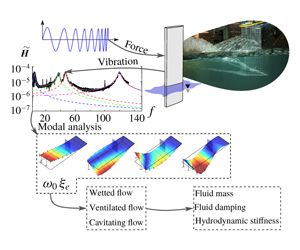Crossref Citations
This article has been cited by the following publications. This list is generated based on data provided by
Crossref.
Harwood, Casey M.
Felli, Mario
Falchi, Massimo
Ceccio, Steven L.
and
Young, Yin L.
2019.
The hydroelastic response of a surface-piercing hydrofoil in multi-phase flows. Part 1. Passive hydroelasticity.
Journal of Fluid Mechanics,
Vol. 881,
Issue. ,
p.
313.
Di Napoli, Isaac M.
and
Harwood, Casey M.
2020.
Design and benchmarking of a robust strain-based 3D shape sensing system.
Ocean Engineering,
Vol. 201,
Issue. ,
p.
107071.
Young, Y.L.
Wright, T.
Yoon, H.
and
Harwood, C.M.
2020.
Dynamic hydroelastic response of a surface-piercing strut in waves and ventilated flows.
Journal of Fluids and Structures,
Vol. 94,
Issue. ,
p.
102899.
Smith, Samuel M.
Venning, James A.
Pearce, Bryce W.
Young, Yin Lu
and
Brandner, Paul A.
2020.
The influence of fluid–structure interaction on cloud cavitation about a flexible hydrofoil. Part 2..
Journal of Fluid Mechanics,
Vol. 897,
Issue. ,
Smith, Samuel M.
Venning, James A.
Pearce, Bryce W.
Young, Yin Lu
and
Brandner, Paul A.
2020.
The influence of fluid–structure interaction on cloud cavitation about a stiff hydrofoil. Part 1..
Journal of Fluid Mechanics,
Vol. 896,
Issue. ,
George, Sijo
and
Ducoin, Antoine
2021.
A coupled Direct Numerical Simulation of 1DOF vibration approach to investigate the transition induced vibration over a hydrofoil.
Journal of Fluids and Structures,
Vol. 105,
Issue. ,
p.
103345.
Chae, Eun Jung
and
Young, Yin Lu
2021.
Influence of spanwise flexibility on steady and dynamic responses of airfoils vs hydrofoils.
Physics of Fluids,
Vol. 33,
Issue. 6,
Liao, Yingqian
Martins, Joaquim R.R.A.
and
Young, Yin Lu
2021.
3-D high-fidelity hydrostructural optimization of cavitation-free composite lifting surfaces.
Composite Structures,
Vol. 268,
Issue. ,
p.
113937.
Magionesi, F.
Dubbioso, G.
and
Muscari, R.
2022.
Contribution of tip and hub vortex to the structural response of a marine rudder in the propeller slipstream.
Journal of Fluid Mechanics,
Vol. 946,
Issue. ,
Zhi, Yuchang
Zhan, Jiemin
Huang, Renfang
Qiu, Rundi
and
Wang, Yiwei
2022.
Numerical investigations into the ventilation elimination mechanism of a surface-piercing hydrofoil.
Ocean Engineering,
Vol. 243,
Issue. ,
p.
110225.
Young, Yin Lu
Chang, Jasmine C.
Smith, Samuel M.
Venning, James A.
Pearce, Bryce W.
and
Brandner, Paul A.
2022.
The influence of fluid–structure interaction on cloud cavitation about a rigid and a flexible hydrofoil. Part 3.
Journal of Fluid Mechanics,
Vol. 934,
Issue. ,
Zhang, Hou-sheng
Guo, Zhi-pu
Wu, Qin
Zhang, Han-zhe
and
Wang, Guo-yu
2022.
Experimental Investigation of fluid-structure interaction of composite hydrofoils in cavitating flow.
Journal of Hydrodynamics,
Vol. 34,
Issue. 2,
p.
207.
Wang, Yongjiu
Huang, Chenguang
Du, Tezhuan
Huang, Renfang
Zhi, Yuchang
Wang, Yiwei
Xiao, Zhijian
and
Bian, Zhendong
2022.
Research on ventilation and supercavitation mechanism of high-speed surface-piercing hydrofoil.
Physics of Fluids,
Vol. 34,
Issue. 2,
Zeng, Yongshun
Yao, Zhifeng
Huang, Biao
Wu, Qin
and
Wang, Fujun
2022.
Experimental investigation of the hydrodynamic damping of a vibrating hydrofoil in cavitating flow.
Ocean Engineering,
Vol. 266,
Issue. ,
p.
112734.
Karimpour, Ali
Rahmatalla, Salam
and
Harwood, Casey
2022.
Effect of Directional Added Mass on Highway Bridge Response during Flood Events.
Infrastructures,
Vol. 7,
Issue. 3,
p.
42.
Jiang, Yichen
Wang, Chuansheng
Li, Jingguang
Wang, Chunxu
and
Wang, Qing
2023.
Study on Flow-induced Vibration Characteristics of 2-DOF Hydrofoil Based on Fluid-Structure Coupling Method.
Journal of Marine Science and Application,
Vol. 22,
Issue. 4,
p.
775.
Young, Yin Lu
Valles, Zachary
Di Napoli, Isaac
Montero, Francisco M.
Minerva, Luigi F.
and
Harwood, Casey
2023.
Wave effects on the hydroelastic response of a surface-piercing hydrofoil. Part 2. Cavitating and ventilating flows.
Journal of Fluid Mechanics,
Vol. 965,
Issue. ,
Young, Yin Lu
Valles, Zachary
Di Napoli, Isaac
Montero, Francisco M.
Minerva, Luigi F.
and
Harwood, Casey
2023.
Wave effects on the hydroelastic response of a surface-piercing hydrofoil. Part 1. Fully wetted and ventilated flows.
Journal of Fluid Mechanics,
Vol. 963,
Issue. ,
Zhi, Yuchang
Huang, Renfang
Qiu, Rundi
Wang, Yiwei
Sun, Qun
and
Cai, Shuting
2023.
Numerical investigation of the tip-vortex-induced ventilation formation mechanism for a surface-piercing hydrofoil.
Physics of Fluids,
Vol. 35,
Issue. 12,
Liu, Yunqing
Zhang, Hanzhe
Wu, Qin
Yao, Zhifeng
Huang, Biao
and
Wang, Guoyu
2023.
Bend-twist coupling effects on the cavitation behavior and hydroelastic response of composite hydrofoils.
International Journal of Multiphase Flow,
Vol. 158,
Issue. ,
p.
104286.



